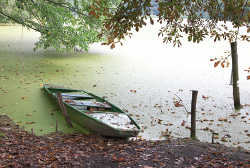Eutrophication: The Life-Cycle of a Pond or Lake
Wonder Why Your Pond Looks Gross? It May Not Just Be Your Septic…It Could Be Something Referred To As Eutrophication
Lakes and ponds can make otherwise ordinary properties into extraordinary retreats. These water features provide aesthetic beauty, attract wildlife, and seem to lend a calming feel to a property’s atmosphere. In many cases, people purchase a property specifically for these features or the myriad of recreational activities they provide. Whether your pond or lake is man-made or natural, there is a life-cycle attached to your pond or lake. The process of eutrophication helps to explain why so many ponds and lakes become unsightly or dirty.
Whatever is happening to your lakefront or pond, it is likely part of a “natural” process known as eutrophication. Eutrophication is a scientific term for the life-cycle of a pond…a natural cycle that all lakes and ponds are destined to complete. This process can take a very long time (hundreds to thousands and even millions of years), however with human presence and land development, we have greatly accelerated this process. As a result, our lakes and ponds require maintenance to halt or reverse the process (at least on a somewhat temporary basis). Even though we refer to it as a “natural” process, this would happen on its own over a very long period of time, our presence and development of land around our lakes and ponds is actually accelerating this process.
The Stages of Eutrophication
- Oligotrophic – a pond or lake with low productivity. These ponds and lakes have less nutrients and thus typically have very little in the way of algae or aquatic plants.
- Mesotrophic – a pond or lake with moderate productivity. For the most part, these bodies of water are free of excessive algae or plants.
- Eutrophic – a pond or lake with high productivity. These ponds and lakes tend to have high levels of phosphates entering through stormwater runoff and from the actual sediment bed within the lake.
- Hypereutrophic – a pond or lake with excessive nutrients. These ponds and lakes tend to be murky and are likely dominated by frequent and severe algal blooms or excessive plant growth.
Find out why we’re the best.
Contact us today to find out how suction dredging can help you restore your pond or waterfront!

